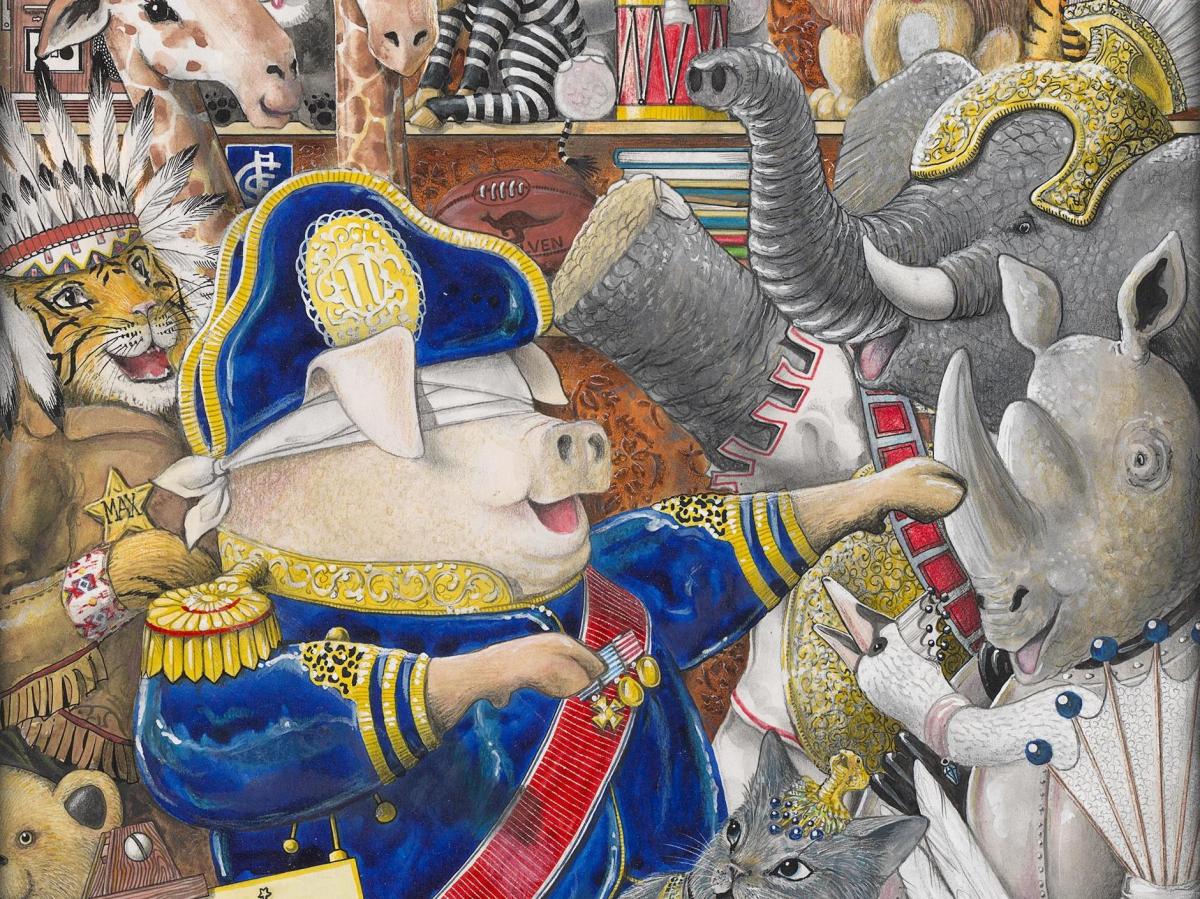‘The other guests enjoyed a lively game of Blind Man’s Bluff’ 1988 illustration for The Eleventh Hour by Graeme Base, published by Viking Kestrel/Penguin Books Australia, Melbourne, 1988, p. 18. Gift of Albert Ullin OAM, 2014 © Graeme Base
Bunyips and Dragons presents work that will be familiar to many, as well as introducing the viewer to new works. The illustrations’ ability to convey emotions makes an immediate impression. For the young person who may still be learning to read, the pictures transcend language. We see happiness, whimsy, sadness and triumph: feelings that are universal.
The works have a delightful sense of informality and playfulness. Of course, the beauty, richness and vibrancy of these pictures have a purpose – to draw in the reader.
It would be hard to discuss children’s book illustrations without discussing the texts and themes of children’s books, because in the most-loved books, the text and illustrations work together. Text from In the House of Baron Albert (with illustrations by Terry Denton) captures the enchantment of reading: “It is a magical room… When the book is opened, suddenly you’re able to see out across the world, beyond the universe. All the wondrous things on earth are opened to you. There is no limit.”
The most enduring children’s texts then leverage the charm of their illustrations to tackle themes that can be difficult at any age: isolation, discrimination, fear, oppression, or a sense of being different from everyone else. They let the reader ask questions that adults often shut down. For example, The Bunyip of Berkeley’s Creek (text by Jenny Wagner and illustrations by Ron Brooks) is an old favourite for many. Through the character of the bunyip, this story opens up themes of identity and place in the world that are important to ask, both as children and adults. The illustrations superbly serve their purpose of carrying the reader through confronting issues.
By showcasing the skill and emotional power of the works, the exhibition establishes these pictures as artworks in their own right. The breadth of materials used is striking. A work by Patricia Mullins provides a prime example: Conté crayon is overlaid with cut and torn paper and nylon ribbon, the characters are clothed in fabric and a real, doll-sized, knitted scarf trails across the surface. This wonderful three-dimensional work epitomises the care, skill and passion these artists put into their work. There is no holding back; no treatment of children’s illustrations as somehow a ‘lesser’ genre.
Both adults and kids will enjoy the video in the third room of the artists at work. There is magic in seeing the images forming on the page, right before our eyes. Unfortunately no seat is provided. Also, as the video is uncaptioned, one is left to try to match the identity of the artists with the accompanying wall-sign.
Disappointingly, the exhibition space is rather stark. The first room is almost harshly bright, and exposed to the noise and roadworks of Flinders St. The second and third rooms are gentler, but an opportunity has been lost here to create a ‘world within a world’ in the exhibition space, through the use of materials such as drapery or wall hangings. Without it, Bunyips and Dragons lacks the sense of intimacy, warmth and enclosure usually associated with children’s reading time.
Furthermore, it seems to have been installed with primarily an adult audience in mind. The displays are largely at adult head height. Kids can sit and draw at a workbench where paper and materials are provided. However, only in the third room are the works hung at a child’s height.
On the day that ArtsHub attended (at the Members’ preview), the exhibition had an unfinished feel. It is possible that some of these issues were due to be addressed before opening to the public.
Rating: 3 out of 5 stars
Bunyips and Dragons: Australian Children’s Book Illustrations
The Ian Potter Centre: NGV Australia
25 July 2015 to 4 October 2015
Free entry
Disclosure: Liz Juniper is a member of the National Gallery of Victoria and attended the Members’ Preview.





